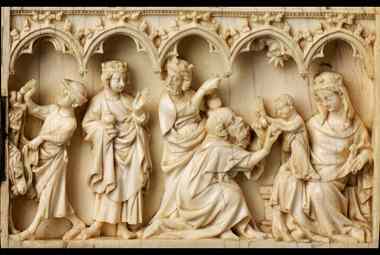When in 1924 the French scholar Raymond Koechlin published his three-volume study of French Gothic Ivories, his catalogue numbered 1,328 objects and was illustrated by some 500 images.
 Since then, many more ivories have surfaced in auction houses as well as private and public collections; valuable articles and catalogues have been written; scientific examination and increasing expertise have all shed more light on these exquisite objects.
Since then, many more ivories have surfaced in auction houses as well as private and public collections; valuable articles and catalogues have been written; scientific examination and increasing expertise have all shed more light on these exquisite objects.
On 15 December 2010 the Gothic Ivories Project, hosted by The Courtauld Institute of Art, goes online promising a “Koechlin for the twenty-first century”.
The Gothic Ivories Project website makes available the first 700 objects from a database that already numbers more than 3,000 ivories.
A detailed entry has been written for each piece and the vast majority are illustrated by high resolution colour images, with multiple views. The final number of objects looks set to triple Koechlin’s figure.
“The project has been made possible by the collaboration of numerous institutions”, comments the Project’s director, Professor John Lowden, “but it is not only the major museums that will benefit from this resource.
Many Gothic ivories are still in private collections, and the website will enable owners to identify what they have.” Project manager Dr Catherine Yvard adds: “The support we received from institutions around the world has been astonishing: all major collections have joined us and smaller collections have also been enthusiastic.
We are equally interested in including objects in private collections, so as to be as comprehensive as possible. The website will be accessible to all and is designed to welcome collectors and curators as well as students and scholars.
As so many Gothic ivories were divided up for sale in the nineteenth century, there is a very real chance of being able to identify what have been thought to be missing parts of a whole. The website makes possible searches by many aspects of content, provenance, function and so on.”
Source: Art Daily [December 15, 2010]